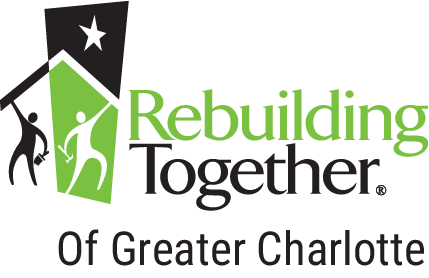Safe and Healthy Housing: Clean
The foundation of every critical home repair and accessibility modification project Rebuilding Together of Greater Charlotte offers at no cost to neighbors in need is our Safe and Healthy Housing Model. This model corrects 25 scientifically proven safety and health hazards common in older homes. A safe and healthy home features eight principles: clean, dry, safe, ventilated, contaminant-free, maintained, thermally controlled, and pest-free.
Cleanliness and Overall Well-Being
We all have to clean. For many people, they realize for the first time how much work and money it takes to maintain a clean home when they start to live on their own. Everyday living adds dirt, dust, and other things we need to remove to maintain a tidy home. From walking in your front door (accompanied by a gust of wind, which brings in leaves and dust!) to cooking, showering, or washing your clothes — these all create dust, allergens, and other pollutants we need to clean up. And even basic cleaning tools and supplies can be a stretch for those on a tight budget.
A clean home allows the occupants to move easily, preventing falls over clutter or slipping hazards from spills. Used linens and clothing should also be laundered regularly to prevent it from piling up and becoming hazardous. Homes with accumulated food debris, like a sink full of unwashed dishes and crumbs on the counter, invite in pests looking for an easy meal. The indoor air quality is also a concern when the home isn’t clean — mold spores, mildew, and the droppings from pests can quickly worsen allergies, asthma, and cause illness.
For larger families, older adults, people on fixed incomes, or those living in poverty, cleaning can be extra challenging. But the health implications of not cleaning your home shouldn't be ignored. A clean home reduces pest infestation and exposure to contaminants. Regular cleaning routines help eliminate dust, allergens, and other pollutants that can adversely affect respiratory health and make pest infestations less likely. A clean home promotes overall well-being.
A cluttered bathroom in one of the homes we serve before improvements from our repairs.
Common Cleaning Improvements in RTGC Projects
One of the most common improvements we provide at no cost for low-income homeowners in the Greater Charlotte area is the removal of old carpeting and installation of easy-to-clean plank vinyl flooring. Sweeping is much easier for most people than running a vacuum, and it's a quicker process to clean that type of flooring. It can also be sanitized much more easily than carpet, and because carpet can trap mold spores as well as lots of dust and dirt, even after being vacuumed, it's best to remove it to maintain an easy-to-clean home.
Another common repair in our no-cost projects involves the replacement of toilets. Toilets with older structures may have complex ornamental designs and bends that are difficult to clean properly, and their low height is a challenge to both use and clean for people with mobility issues. A modern comfort-height toilet has easy-to-clean structures and is easier to get on and off of, especially when paired with grab bars in the bathroom. If a complete toilet replacement isn't desired, mobility companies offer affordable toilet chairs which can improve the user's experience and ability to use the commode independently as well as featuring contact surfaces that are easier to wipe down than the entire toilet.
Cleaning Routine Tips
The best way to get your home clean and keep it that way is to make it part of your daily life.
Make emptying the sink of dishes one the tasks that becomes as automatic as brushing your teeth or locking your door before bed. Many folks also find it helpful to set aside one day a week for deep cleaning areas like their kitchens, bathrooms, or bedrooms. If that feels overwhelming, break it down into a monthly list with one or two smaller tasks, like sweeping the floor or doing a load of laundry. By the time you complete the calendar, your house will be cleaner overall than when you started, and by continuing the cycle, it will stay clean.
If you’re struggling to physically complete cleaning tasks, reach out to friends and family, or other resources, like your social worker. There are various ways to adapt common cleaning tools to make them easier to use. Dustpans with extended handles, vacuums with canisters and hoses that can be pulled rather than upright push-style models, and cordless types eliminate the hassle and tripping risk of being plugged into the wall. Grabber tools are very handy for picking up fallen objects from the floor, as well as opening cabinets. And inventions like automatic robotic vacuums and air purifiers can reduce the amount of time and effort needed to maintain the home.
By regularly cleaning your home, you can minimize the risk of exposure to harmful substances and situations, and promote overall wellness — which is our goal to keep everyone healthy and safe at home.
Would you like to help us provide safe and healthy homes for neighbors in need in the Greater Charlotte area? Donate today!


